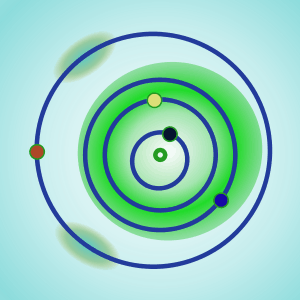(277810) 2006 FV35
| Discovery[1] | |
|---|---|
| Discovery site | Steward Observatory |
| Discovery date | 2006-03-29 |
| Designations | |
Apollo  | |
| Orbital characteristics[2] | |
| Epoch 2455000.5 (2009-Jun-18.0) | |
| Aphelion |
1.3789982 ± 1.4302e-07 AU |
| Perihelion |
0.62308 ± 1.7483e-05 AU |
|
1.0010399 ± 1.0382e-07 AU | |
| Eccentricity |
0.37756 ± 1.7528e-05 |
|
365.82681 ± 5.6912e-05 d | |
|
294.225 ± 0.0010627° | |
| Inclination |
7.1016 ± 0.00044871° |
|
179.5739 ± 0.0002913° | |
|
170.8720 ± 0.00054382° | |
|
2455067.338 ± 0.0010758 jd | |
| Physical characteristics | |
Mean radius | 70–160 m[1] |
| 21.915[3] | |
|
| |
(277810) 2006 FV35 is a small near-Earth asteroid in the Apollo asteroid family. It is a quasi-satellite of Earth.[4] It is also notable for having a low delta-v requirement for rendezvous.[3] Although its orbital period is almost exactly 1 year, the orbit of 2006 FV35 has a high eccentricity which causes it to cross the paths of both Venus and Mars.
Transfer energy
With a semi-major axis of almost exactly 1 AU, 2006 FV35 has a relatively low transfer energy from Earth. The delta-v required to transfer to the asteroid varies between 11 and 13 km/s; this change in delta-v oscillates over an approximately 200-year period with the current transfer cost near its maximum of 13 km/s.[3]
See also
References
- ↑ 1.0 1.1 Gerhard Hahn. "EARN: 2006 FV35". Archived from the original on 2009-05-16. Retrieved 2009-04-19.
- ↑ (277810) 2006 FV35 at the JPL Small-Body Database
- ↑ 3.0 3.1 3.2 Stacey, R. Greg; Connors, Martin (February 2009). "Delta-v requirements for earth co-orbital rendezvous missions". Icarus. (Proof) (7): 822. Bibcode:2009P&SS...57..822G. doi:10.1016/j.pss.2009.01.013.
- ↑ Wajer, P. (2010). "Dynamical evolution of Earth’s quasi-satellites: 2004 GU9 and 2006 FV35". Icarus 209 (2): 488–493. Bibcode:2010Icar..209..488W. doi:10.1016/j.icarus.2010.05.012.